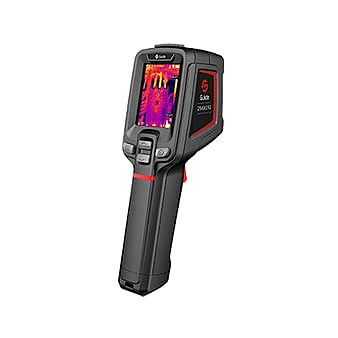FLIR MR265 Thermal Imager
Published on Aug. 15, 2023, 3:55 p.m.
Thermal imaging technology is an advanced technique that captures the infrared radiation of objects and converts it into visible images. This technology enables users to detect temperature differences without direct contact with the object, making it invaluable in various applications. Thermal imagers, combining thermal sensors and image processing technology, find applications in building inspections, medical diagnostics, industrial inspections, and more. This article delves into the FLIR MR265 thermal imager and its applications in building diagnostics and troubleshooting.
The FLIR MR265 is a handheld thermal camera combined with a moisture meter for building inspections and troubleshooting. It delivers crisp thermal images, moisture readings, and visual merging, all in a compact, rugged tool. In this review, we’ll examine the performance, features, and value of this versatile imaging system.

Overview
- 160x120 thermal resolution
- Integrated moisture meter with external pin probe
- MSX image enhancement technology
- Laser pointer and work lights
- Rugged, IP54 enclosure
- Rechargeable battery
Features
-
Moisture readings: The pinless moisture sensor quickly indicates the moisture content of materials with excellent repeatability. The external pin probe allows deeper penetration.
-
MSX enhancement: Embosses visual details onto the thermal images for better orientation and problem identification.
-
Laser pointer: Marks the precise area of concern on the infrared image.
-
Wide temperature range: Detects temperatures from -4°F to 482°F (-20°C to +250°C).
-
Field-ready design: With IP54 enclosure, durable LCD, and battery for 3.5 hours of use.
Image Quality
With its 160x120 pixel thermal sensor, the MR265 produces high resolution images that capture fine detail. Thermal sensitivity is excellent at \<0.04°C, providing the accuracy needed for moisture and insulation issues. The MSX feature overlays edges from the visual spectrum onto the IR imagery, providing exceptional thermal context. Overall, the image quality enables pinpointing moisture intrusion, air leaks, and other building anomalies.
Ease of Use
Despite its advanced imaging capabilities, the MR265 maintains simple and intuitive controls. The responsive touchscreen streamlines navigation of menus and modes. Auto-orientation keeps images right-side up when rotating the camera. Overall, it achieves that perfect balance of professional-grade performance and easy operation.
Technical Parameters Analysis
The performance of a thermal imager is influenced by several key parameters, including resolution, sensitivity, and temperature range. Resolution refers to the smallest temperature difference that a thermal imager can distinguish, usually measured in pixels. Higher resolution means clearer images, aiding in precise target identification and improved detection accuracy. Another crucial parameter is sensitivity, which determines the minimum temperature change that the thermal imager can detect. Higher sensitivity means the thermal imager can capture smaller temperature differences, which is essential for detecting subtle issues. Additionally, the temperature range is also an important factor to consider for the applicability of a thermal imager. Different applications may require different temperature detection ranges, making the selection of an appropriate temperature range crucial.

Applications
The MR265 leverages its thermal-visible-moisture trinity to expertly handle:
- Building moisture investigations
- HVAC inspections
- Energy audits
- Construction defect analysis
- And other applications where heat and moisture visibility is critical.
Use Cases
- Finding water leaks and moisture intrusion
- Inspecting insulation, ductwork, and HVAC systems
- Identifying heat loss spots
- Checking electrical systems and connections
- Locating pest infestations
Pros
- Excellent price-to-performance ratio
- Integrated moisture and thermal imaging
- Laser pointer for precisely identifying issues
- Rugged, ergonomic design
- Intuitive interface and controls
Cons
- Lower resolution thermal sensor
- Mediocre battery life
- WiFi connectivity can be spotty
Value
With a retail price of $1999, the MR265 sits in the upper mid-range of handheld thermal imagers. For inspectors and contractors who need combined thermal and moisture imaging, the price is easily justified by the capabilities and image quality. Compared to buying separate thermal and moisture cameras, it provides good value.
Conclusion
With its crisp thermal images, accurate moisture readings, laser pointer, and rugged build, the FLIR MR265 thermal-moisture imager excels at building diagnostics and insulation deficiencies. It neatly combines multiple inspection tools into one intuitive instrument. For those needing high-performance imaging backed by the FLIR name, the MR265 is an outstanding choice.
Future Outlook
With the continuous development of science and technology, thermal imaging technology will have broader applications in the future. We can anticipate that thermal imagers will play a greater role in medical diagnostics, security surveillance, agricultural production, and other fields. With advancements in technology and cost reduction, thermal imagers will become more widespread, becoming an indispensable tool in people’s daily lives.
Specifications
- Thermal resolution: 160 x 120 pixels
- Thermal sensitivity: 100 mK
- Field of view: 50° × 38°
- Focus: Fixed focus, minimum focus distance 1.31 ft
- Frame rate: 9 Hz
- Image presentation: IR image, visual image, MSX, Picture-in-Picture
- Color palettes: Iron, Rainbow, Black & White
- Image modes: Infrared, visual, MSX, Fusion
- Laser pointer: Class 2 laser, accuracy +/- 1°
- Moisture meter: Pinless, 0 to 100 scale
- Battery: Rechargeable 3.7V Li-ion battery, >4 hour operating time
- Storage: Micro SD card
- Connectivity: WiFi, USB 2.0
- Operating temperature: -10°C to +50°C
Box Includes
- FLIR MR265 camera
- MR02 moisture pin probe
- USB charger and cable
- Printed documentation
Usage Tips
- Charge the battery fully before first use
- Adjust emissivity settings for the material being scanned
- Use MSX mode to add detail and context to thermal images
- Take visible light images of the same areas for further analysis
- Move slowly and avoid drastic temperature changes when scanning for moisture
- Use the laser pointer to precisely identify areas of interest
- Save images to SD card for record keeping and reporting



















